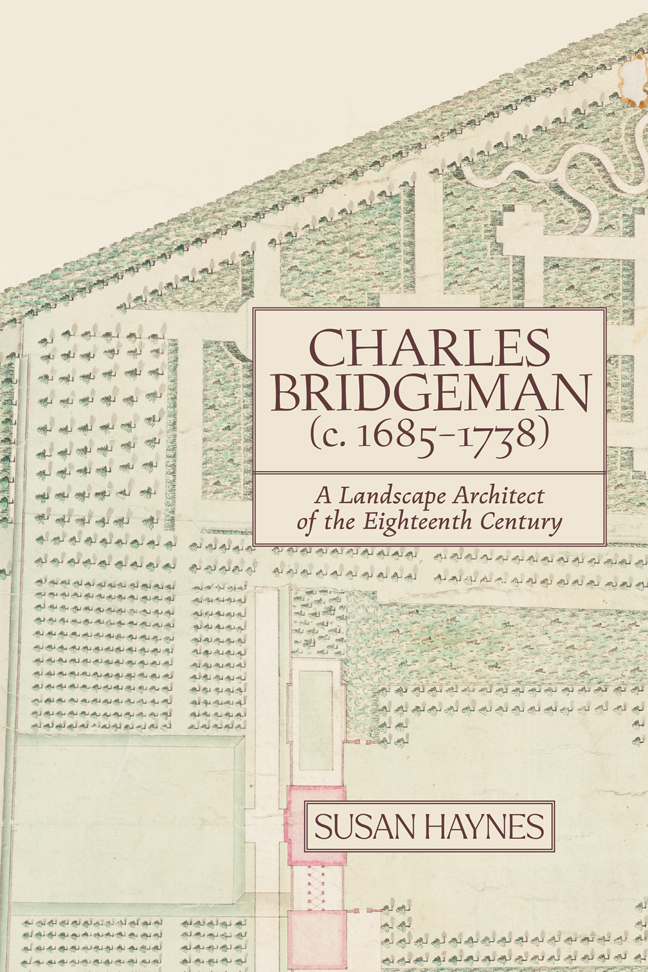Book contents
- Frontmatter
- Dedication
- Maps
- Contents
- List of Illustrations
- Acknowledgements
- List of Abbreviations
- Introduction
- Chapter 1 Who Was Charles Bridgeman?
- Chapter 2 Towards A Reliable Corpus
- Chapter 3 A Revised Catalogue
- Chapter 4 Reading The Plans
- Chapter 5 The Art-Historical Context Revisited
- Chapter 6 The ‘Ingenious Mr Bridgeman’
- Chapter 7 Building a Landscape
- Chapter 8 A Commercial Enterprise
- Conclusion
- Appendix I A summary of Willis's catalogue from Charles Bridgeman and the English Landscape Garden
- Appendix II A revised catalogue
- Appendix III Bridgeman's projects by year
- Appendix IV Bridgeman's income
- Gazetteer of Bridgeman sites
- Glossary
- Bibliography
- Index
- Miscellaneous Endmatter
Chapter 8 - A Commercial Enterprise
Published online by Cambridge University Press: 21 February 2024
- Frontmatter
- Dedication
- Maps
- Contents
- List of Illustrations
- Acknowledgements
- List of Abbreviations
- Introduction
- Chapter 1 Who Was Charles Bridgeman?
- Chapter 2 Towards A Reliable Corpus
- Chapter 3 A Revised Catalogue
- Chapter 4 Reading The Plans
- Chapter 5 The Art-Historical Context Revisited
- Chapter 6 The ‘Ingenious Mr Bridgeman’
- Chapter 7 Building a Landscape
- Chapter 8 A Commercial Enterprise
- Conclusion
- Appendix I A summary of Willis's catalogue from Charles Bridgeman and the English Landscape Garden
- Appendix II A revised catalogue
- Appendix III Bridgeman's projects by year
- Appendix IV Bridgeman's income
- Gazetteer of Bridgeman sites
- Glossary
- Bibliography
- Index
- Miscellaneous Endmatter
Summary
OF ALL THE aspects of creating designed landscapes, perhaps the one most regularly ignored is the intricacy of financing them. This is partly because art history, in regard to gardening at least, finds the philosophical and design aspects of gardens more interesting than how much they cost. It is also because, particularly before the mid-eighteenth century and the gentlemen improvers, it is almost impossible to find systematically costed accounts in the archives of either the clients or the practitioners, and therefore quite difficult to be precise about the money that changed hands. However, it is obvious that creating these landscapes was spectacularly expensive, and required a provision of goods and services which had to be paid for.
Yet the idea of Bridgeman's clients as consumers is completely missing from the writing about Bridgeman, and rarely makes more than a footnote in the writing about his predecessors and contemporaries. Most commentary on the rise of consumerism in the eighteenth century has tended to concentrate on the lower and ‘middling’ classes; as Weatherill puts it, the desire ‘to emulate those of higher social rank, in order to keep up appearances’ was the main driver of this significant change in behaviour (Weatherill 1988, 194). Clearly the emulation of the rich and powerful by the ‘middling sort’ is of less interest here, since Bridgeman worked exclusively for the rich and the powerful, the ‘propertied people’ who Langford characterises as trailing ‘their possessions before the gaze, fascinated, awed, resentful, of the unpropertied people who were their employees, servants, or merely spectators’ (Langford 1991, 11). Bridgeman's clients were drawn from the nobility with inherited wealth and land. These clients were the ‘rich who led the way’ and ‘indulged in an orgy of spending’ (McKendrick et al. 1983, 10); they were the powerful men, and occasionally women, who saw themselves as the arbiters of fashionable taste. However, Bridgeman's clients were clearly not immune to ‘the compulsive power of fashion begotten by social competition’ (McKendrick et al. 1983, 10). An understanding of ‘taste’ was a badge of belonging to, and remaining within, the elite.
Paradoxically, the notion of art and taste, which has largely concealed the understanding of Bridgeman's clients and consumers, was generated by them.
- Type
- Chapter
- Information
- Charles Bridgeman (c. 1685-1738)A Landscape Architect of the Eighteenth Century, pp. 137 - 166Publisher: Boydell & BrewerPrint publication year: 2023



